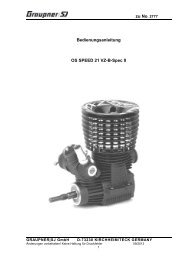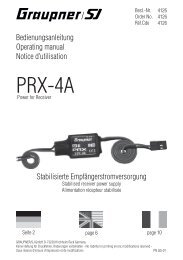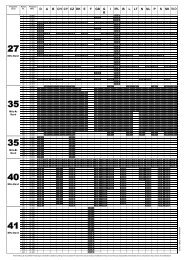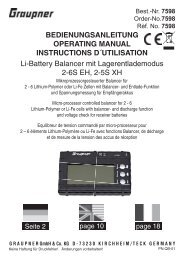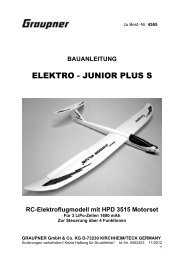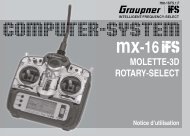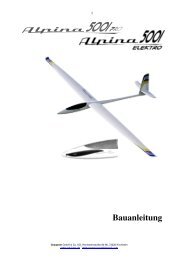Create successful ePaper yourself
Turn your PDF publications into a flip-book with our unique Google optimized e-Paper software.
The GRP lugs can now be glued permanently in place using UHU plus endfest 300<br />
(slow-setting epoxy) or thickened epoxy laminating resin, applied through the opening<br />
in the top of the fin which you cut previously (Fig. 3). You may need to extend the<br />
factory-cut slots in the rudder (14) slightly in order to obtain equally large rudder<br />
deflection to both sides of centre.<br />
Drill a 6 mm Ø hole right through the rudder (14) at the marked point. Cut a 100 mm<br />
length from the M3 studding supplied (Fig. 46). The M3 threaded brass sleeves are<br />
screwed on both ends of the studding, where they are locked in place using M3 selflocking<br />
nuts. The horn lugs are then fitted on both ends of the studding. The<br />
completed horn assembly must be symmetrical on both sides as shown in Figs. 47<br />
and 48, otherwise rudder travel will not be equal on both sides. Install this assembly in<br />
the rudder, screwing the threaded sleeves onto the studding, and apply plenty of UHU<br />
plus endfest 300 epoxy to the M6 through-hole to secure the horn (small items in bag<br />
IV).<br />
The prepared rudder (14), complete with horn, can now be attached to the fuselage.<br />
Cut slots in both sides of the fuselage to clear the horns, and check that maximum<br />
rudder travel is available on both sides of centre. Caution: the marked line on the<br />
fuselage is only a guide, and may not be accurate for your particular installation.<br />
The rudder function (14) is operated by means of two pull-pull cables (braided cable,<br />
0.8 Ø x 2000). Cut slots in the fuselage for the cables at the marked positions, and<br />
open them up slightly if necessary to avoid the cables chafing on the GRP fuselage<br />
skin. It is also possible to glue two small pieces of plastic sleeve in the slots (as for the<br />
steerable tailwheel), and run the cables through the sleeves (rudder cables in bag IV).<br />
If you wish to use standard servos to operate the rudder (14) you will need to install<br />
the maxi-lever (Fig. 95) in order to obtain suitably large rudder deflections, as required<br />
especially for 3-D flying (torque rolls etc.). If you are using two standard-size rudder<br />
servos, couple them together as shown in Fig. 38 (four M3 clevises, four locknuts, two<br />
threaded rods). Small parts to make up the rudder linkage, maxi-lever (Figs. 46, 93,<br />
95) in accessory pack IV.<br />
Wing / fuselage joints<br />
The wing joiner tube (15) is supplied overlength and has to be cut to the correct<br />
length. The overall length is the sum of the maximum fuselage width (wing joiner<br />
sleeve position in the fuselage) and the depth of the joiner sleeves in the left and right<br />
wing roots. Measure carefully, carry out the calculation, then calculate again before<br />
shortening the tube. We recommend that you saw off slightly less than required from<br />
the tube (15), then check and shorten it again as required. The absolute maximum<br />
permissible axial play in the wing joiner tube (14) with the wings fitted to the fuselage<br />
is about 5 mm. An approximate guide for the overall length of the joiner tube is 1030<br />
mm.<br />
Fit the wing joiner tube (15) and the incidence tube (brass tube, 9 Ø x 500) in the<br />
fuselage, and plug in the wings. The holes in the wing roots and the openings in the<br />
fuselage must line up correctly, and the wings must rest flat against the root fairings,<br />
with no gap top or bottom, front or back.<br />
The incidence tube (9 mm Ø brass tube) can now be glued in the wings using UHU<br />
13





